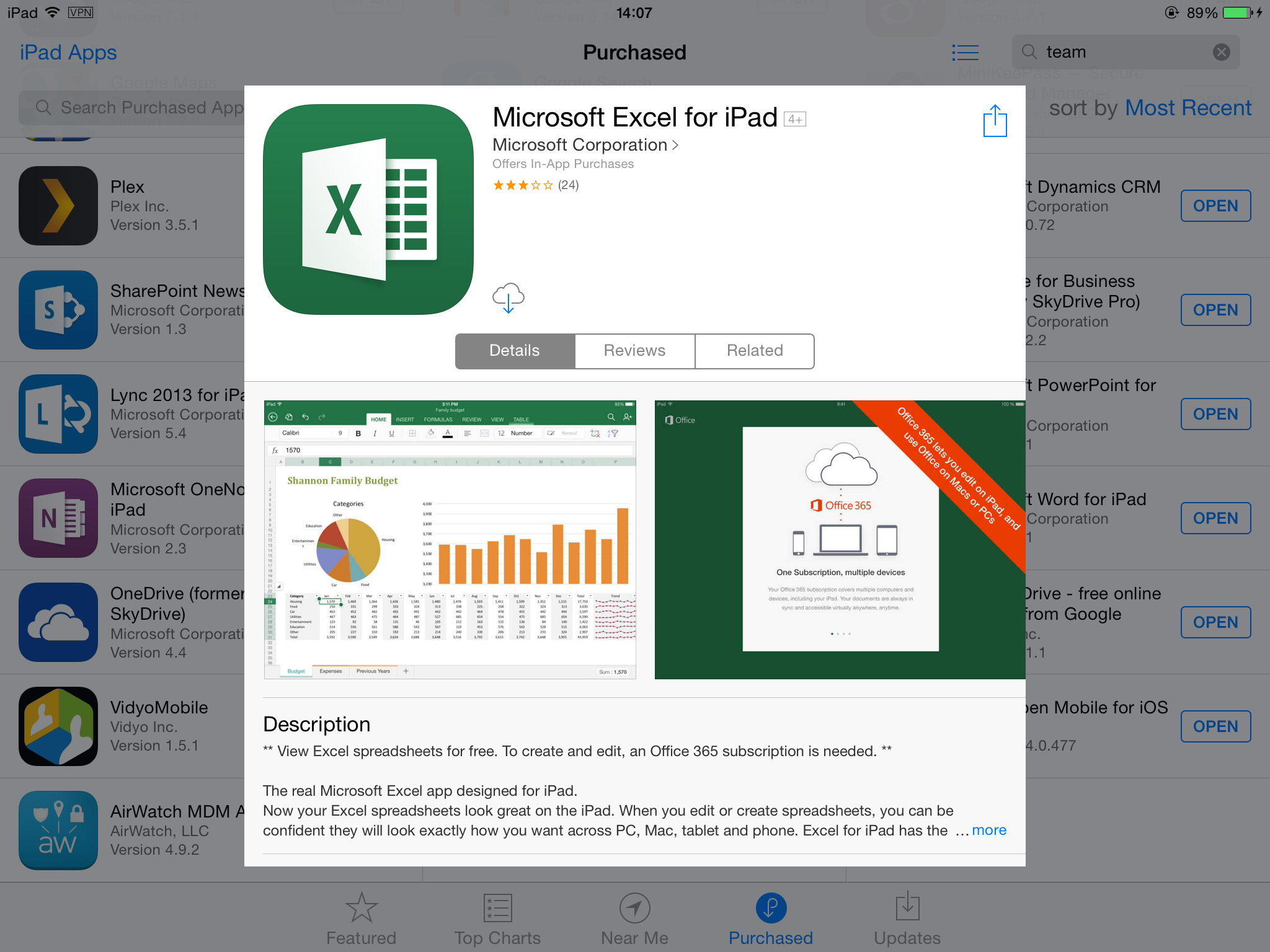Excel for iPad and iPhone Excel for iOS can be used to create spreadsheets, as long as you register for a Microsoft ID. Once you have logged into your account you will have almost all the features. Microsoft today released updates to its suite of Office apps for iPad, including Word, PowerPoint, and Excel. Notably, Excel for iPad now supports Split View, which allows you to open two.
The Microsoft Excel application is authentically adapted for the iPad. Now, your Excel spreadsheets are displayed perfectly on iPad. When you edit or create spreadsheets, you can be certain that they will have exactly the same appearance on your PC, your Mac, your tablet or your phone.
Excel for iPad offers an interface similar to that of Office on all other platforms. It’s touch controls, and intuitive flow allows you to take the application in hand in no time.
Excel for iPad is part of Microsoft Office Suite. With an Office 365 subscription, you get updated versions of Microsoft Office on your PC, your Mac, your tablet or your phone.
The aspects of Excel spreadsheets are amazing:
- Formulas, tables, graphs, comments, hyperlinks, spark lines, updates in conditional form, everything is there. Nothing escapes you.
- The Excel spreadsheets are displayed to perfection, as on your PC or Mac.
- You can easily view the attachments to e-mail messages and access all your Excel spreadsheets from OneDrive, or SharePoint.
- You can return on an Excel file where you left off, because Excel for iPad will regain the last location where you were, whatever device you used to edit the document.
Creating and editing with confidence
- When you change a spreadsheet, its content and its formatting are identical on all your devices: PC, Mac, tablet or phone.
- Convert the figures into ideas, using formulas, charts, tables, of sorts, of filters and much more.
- A specifically dedicated keyboard allows you to add the figures and formulas much more quickly than with a regular keyboard touch.
- Excel automatically saves your spreadsheet. So you're sure not to lose any of your work, even when you're on the move.
- Share your work with your colleagues by simply sending a hyperlink by electronic mail or by disseminating the calculation sheet fully.

Experience familiar Microsoft Office
- Nothing is easier than to select the application and begin to use, because you know how to use Excel, and with no changes.
- The menu options and navigation modes that you already know have been adapted at the touch experience. No need for a keyboard.
Qualificationsrequirement:
To be able to create and modify Excel spreadsheets, you need to have one of the following plans of Office 365 subscription:
1. Office 365 Family
2. Office 365 Small Business Premium
3. Office 365 Average Business
4. Office 365 Enterprise E3 and E4 (Business and for the Government Enterprise)
5. Office 365 Education A3 and A4 for teachers
6. Office 365 ProPlus
7. Office 365 University
Subscriptions to evaluation of Office 365
If you do not have a subscription, you can buy Office 365 family from the Excel application for iPad. Office 365 family allows you to always have updated versions of Office on a maximum of 5 PC or Mac and 5 mobile devices, with 20 Gigabyte of archiving in the cloud on One Drive, as well as with minutes on Skype world (if available).

The subscription of Office 365 purchased from the application will be charged on your iTunes account, and automatically renewed in the 24 hours preceding the end of the current subscription period, except if you have previously disabled the automatic renewal. You can manage subscriptions and disable the automatic renewal via the settings of your iTunes account after the purchase. You cannot cancel a subscription during the current subscription period.
Microsoft’s Office suite of applications has been a staple in most people’s personal and professional lives for decades, and their introduction on the iPad several years ago felt like a turning point in the iPad’s quest to becoming a “serious computer.” Several years later, these apps have grown up and are better than they’ve ever been before. We recently dove into how Word adapted itself to the iPad and found it to have some compromises over the desktop version, but was ultimately a very capable app that would work for most people. Excel has also made some compromises to work on iOS, but these compromises hurt the overall experience to the point that we expect most people will find this version of the app inadequate.
Welcome to Excel on the iPad
Microsoft Excel is a free download from the App Store, but you’re going to need an Office 365 subscription to actually do anything besides read Excel files. At as little as $6.99/month or $70/year and including all the other Office apps, as well as 1TB of OneDrive cloud storage, this is one of the best deals in productivity software out there. That said, this is another subscription and you’ll have to decide if access to these apps is worth a recurring cost.
If you decide it’s worth your money, then you’ll get full access to Excel’s features on your iPad, and your use cases are going to heavily determine how much you’re going to like this experience. If you are a light spreadsheet user and just want to edit XLSX files here and there, then you’re probably going to enjoy the app. However, if you do more complex work in Excel or use it to edit multiple file types, then this version of the app is very lackluster.

The Good Stuff
Excel has some good things going for it. I personally enjoy the default history view of files you have edited in the past. This syncs across all your devices, so editing a file on your Mac will throw it to the top of your list of recent files on the iPad. This makes moving between devices quite seamless, but the only way you get this cross-device feature to work is if you are storing your files in OneDrive. If you’re using this app, then you’re paying for 1TB of storage, so this is at least possible, but it definitely removes some of the flexibility you have in handling your files. I’d highly recommend using OneDrive if at all possible to have the most seamless experience.
If you want to start fresh, Excel offers a few dozen templates ranging from budget calculators to invoices to schedules, in addition to the traditional blank spreadsheet. These are nice starting points, and you can download different templates online and open them seamlessly in Excel. Your first run at editing these files will likely be pretty smooth as well, as you can tap around and do most basic functions intuitively. Especially if you’re using an external keyboard on your iPad, the app initially feels quite similar to the desktop app. You’ll have a few cells filled out and charts created in no time.
I’m also happy to report that the iPad app loads complex documents quickly and you can navigate between large data sets across as many tabs as you can throw at it with ease. I was testing on a 2018 iPad Pro, so older iPads might not be quite as smooth, but I have a spreadsheet with 200,000 rows of data that pushes my 2015 MacBook Pro to its limits, but that same document didn’t seem to push the iPad at all.
The Compromises Begin
Once you get past these initial steps, it likely won’t be long before you run into things that are either slower than they are on the desktop or simply not possible. The first thing that jumps out is that there are zero keyboard shortcuts in the app. You literally can’t do anything but type with the keyboard, which on its own makes this a tough sell for many people. This means tons of tapping and digging into menus that you simply don’t have to do in other versions of Excel.
The basically non-existent keyboard controls make lots of actions either harder than they are on the desktop, or at least different enough that people (including me!) will assume some features don’t exist because they can’t be done in the ways they expect. For example, if you want to delete a few rows in a spreadsheet on Excel for macOS, you would select the row header of the first row, scroll to the last row, Shift+click it, and then select Delete rows from the contextual menu. On the iPad, you have to select one row with the row header, but then you need to drag that selection to wherever you want it to end. Then select Delete from the menu. It took me way longer to figure this out than I’d like to admit, and it’s also less convenient for deleting more than a couple rows from a document. If you’re removing 500 rows at a time, this is not the best way to do it.
Excel also benefits from the precision of a mouse on the desktop. The iPad doesn’t really support a mouse (yet), so you need to do everything with your fingers. Again, for simple spreadsheets this might be fine, but for more advanced workflows, your fingers may be woefully inaccurate.
“But what about the Apple Pencil?” you might ask. Well, Excel has support for the Apple Pencil, but it’s not what you’d expect. The only thing you can do with the Apple Pencil is draw freehand on top of your spreadsheets. Maybe there are more people out there who need this more than we think, but adding a remedial drawing interface over what should be a powerful productivity tool feels like the wrong move.
I’ll stop there, but the main takeaway is that the interface feels stuck between two worlds in its current form. It is not as powerful as the desktop version and it’s not as easy to use as the best iOS apps out there. It’s stuck in a sort of limbo where it is making compromises on both ends but is not as powerful or efficient as the desktop app and not as optimized for touch as great iOS apps.
Getting Things In and Out of Excel
For many people, Excel is a place where data gets processed before being passed off to its final destination. One example would be downloading a large data set in a CSV, importing it into Excel, and running some analytics on that data. Maybe you want to make some changes and save that as a new CSV, even.
Excel can open most of the file types you would expect, although you should know that it uses an online file conversion tool to convert things like CSVs to Excel documents. This may be fine by you, but could be an issue if it is a very large file that takes a long time to upload and then re-download from this conversion service. Or if you’re handling sensitive data that isn’t supposed to be uploaded anywhere, this is going to be a problem.
When it comes to saving a file when you’re done with it, you have 3 options:
- Excel document (.xlsx)
- OpenDocument Spreadsheet (.ods)
The killer here is the lack of CSV support. Even if you open a CSV you got elsewhere, the app won’t let you save it as a CSV, you must convert it to one of the above formats. I’m not sure who’s using Excel but wants OpenDocument files, but maybe they’re out there.
The bottom line is that you should only really expect to get .xlsx documents out of Excel for the iPad. It’s inconvenient to get anything else, and the options available are probably not what you want anyway.
Numbers For Ipad
As a final note on getting content out of Excel, copy/pasting is a bit odd, to say the least. Let’s take a basic example of copying some plain text out of a few cells. You can switch to another tab or a whole other document in Excel and paste it without a problem. However, it’s a real toss up what will happen everywhere else. Pasting into Drafts and a note in OmniFocus pasted the data in tab-separated text, which is good. However, most apps accept the data as an image. Pasting into Apple Notes and other note-taking apps gives you an image of a spreadsheet. This is not a phenomenon you’ll see when pasting data from something like Apple Numbers or Google Sheets, so it’s very odd to see from Excel.
Files Integration
On a better note, Excel works pretty well with the Files app for iOS. Microsoft office 2008 for mac os x. If you have a file saved to iCloud or Dropbox, you can open it in Excel on the iPad, do whatever you want with it, and then save the changes directly to where the file came from. You even get all of Excel’s autosave functions and “recent documents” features when editing files outside of OneDrive, which is nice (the recent documents list only works locally though, and will not sync across other devices).
Collaborative Spreadsheets
Excel for the iPad supports collaboration both in the form of comments and real time collaborative editing. Any document that is saved to OneDrive can be shared with someone (or many people) else so they can view the file. Depending on what you’re doing, you can choose to give each person access to comment only, or to make edits. Torrent adobe premiere pro cc for mac.
Comments show up in the document like all other versions of Excel, and the app will send you a push notification when comments come in. These comments of course sync across all devices accessing your spreadsheet.

If you give someone else the ability to edit, they’ll be able to open the document and start making changes or leaving comments in real time. If they are in the document at the same time as you, you’ll be able to see them making changes as they go. It’s pretty slick and works reliably in my experience.
Alternatives
There are really two alternatives to Excel that matter on the iPad: Numbers and Google Sheets. Numbers comes from Apple and is a better overall piece of software in my opinion. While Excel feels caught between a desktop and mobile experience, Numbers feels much more like a “no compromises” experience when compared to the desktop-based version. It has a friendlier interface, feels like it was designed for iOS, takes advantage of most modern iOS features, and generally just gets out of your way and lets you work. It’s not nearly as good at real-time collaboration, though.
Google Sheets is not a good iPad app, as it bucks iOS standards at almost every turn and manages to feel both too complicated and too limiting all at once. Its real-time collaboration is excellent, but that’s the only major win in my book.
Both of these apps suffer from the one killer feature that Excel has though, and that’s…being Excel. As much as you might like Numbers or Sheets, we live in an Excel world and usually it’s just not an option to use anything else. Free dwg viewer for mac. Excel has some warts, but it’s still easier to use than converting XLSX documents to Numbers, making changes, and saving a copy out as XLSX time and time again.
The Overall Experience
Excel on the iPad is a competent spreadsheet application, and if your needs are simple or you just plan on making edits to spreadsheets you created on macOS or Windows, then you’ll likely really enjoy this app. However, if you are looking to replace your desktop computer with an iPad and you do a lot of work, especially complex work, in Excel, then it’s a much tougher sell.
Microsoft Excel For Ipad Pro
Hopefully, Microsoft will continue to iterate on this app and bring it up to the standards they hold the desktop version to, but as of right now it has a long ways to go. Collaboration works great and performance is impressive, but complex operations and customization that many people rely on just isn’t there yet.
Our Must-Have, Most Used Productivity Apps
We spend an inordinate amount of time sorting through hundreds of apps to find the very best. We put together a short list of our must-have, most-used apps for increasing productivity.
